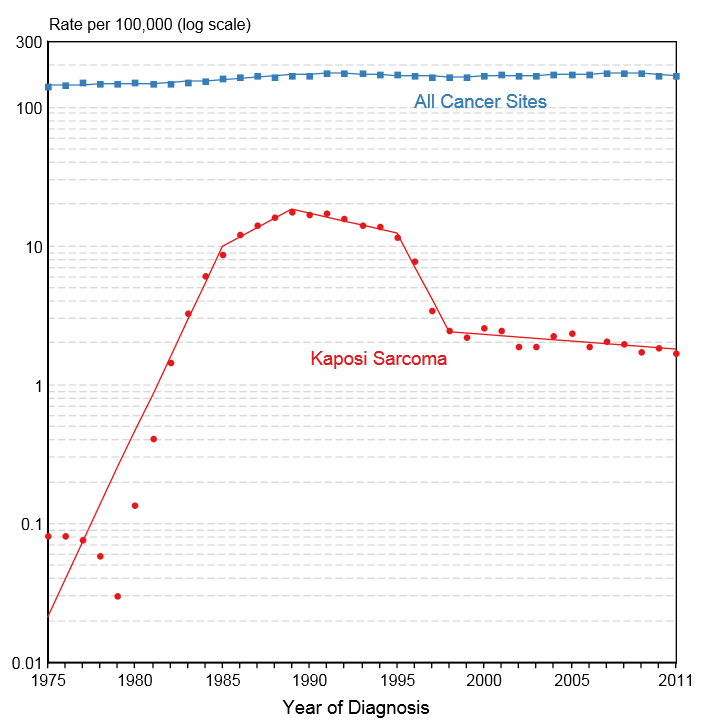Kaposi's sarcoma epidemiology and demographics: Difference between revisions
Rim Halaby (talk | contribs) |
Rim Halaby (talk | contribs) |
||
| Line 3: | Line 3: | ||
{{CMG}}; {{AE}} {{Rim}} | {{CMG}}; {{AE}} {{Rim}} | ||
==Overview== | ==Overview== | ||
In the United States, the age-adjusted [[prevalence]] of Kaposi sarcoma is 8.1 per 100,000 in 2011.<ref name="SEER">Howlader N, Noone AM, Krapcho M, Garshell J, Miller D, Altekruse SF, Kosary CL, Yu M, Ruhl J, Tatalovich Z,Mariotto A, Lewis DR, Chen HS, Feuer EJ, Cronin KA (eds). SEER Cancer Statistics Review, 1975-2011, National Cancer Institute. Bethesda, MD, http://seer.cancer.gov/csr/1975_2011/, based on November 2013 SEER data submission, posted to the SEER web site, April 2014.</ref> | The epidemiology of Kaposi Sarcoma varies depending on its type. Before [[AIDS]], Kaposi sarcoma was relatively rare. In the early epidemic of [[AIDS]], the incidence of HIV-related Kaposi sarcoma significantly increased;<ref name=cancer.gov>[http://www.cancer.org/cancer/kaposisarcoma/detailedguide/kaposi-sarcoma-what-is-key-statistics]</ref> however, antiretroviral treatment lead to a decrease in the incidence of HIV related Kaposi sarcoma.<ref name="pmid12853764">{{cite journal| author=Portsmouth S, Stebbing J, Gill J, Mandalia S, Bower M, Nelson M et al.| title=A comparison of regimens based on non-nucleoside reverse transcriptase inhibitors or protease inhibitors in preventing Kaposi's sarcoma. | journal=AIDS | year= 2003 | volume= 17 | issue= 11 | pages= F17-22 | pmid=12853764 | doi=10.1097/01.aids.0000076309.76477.f1 | pmc= | url=http://www.ncbi.nlm.nih.gov/entrez/eutils/elink.fcgi?dbfrom=pubmed&tool=sumsearch.org/cite&retmode=ref&cmd=prlinks&id=12853764 }} </ref><ref name="pmid16849755">{{cite journal| author=Grabar S, Abraham B, Mahamat A, Del Giudice P, Rosenthal E, Costagliola D| title=Differential impact of combination antiretroviral therapy in preventing Kaposi's sarcoma with and without visceral involvement. | journal=J Clin Oncol | year= 2006 | volume= 24 | issue= 21 | pages= 3408-14 | pmid=16849755 | doi=10.1200/JCO.2005.05.4072 | pmc= | url=http://www.ncbi.nlm.nih.gov/entrez/eutils/elink.fcgi?dbfrom=pubmed&tool=sumsearch.org/cite&retmode=ref&cmd=prlinks&id=16849755 }} </ref> While endemic African Kaposi sarcoma is more common in African Bantu, classic Kaposi sarcoma is more prevalent in Middle Eastern countries particularly among males and individuals from Jewish descent. The incidence of Kaposi sarcoma is markedly increased in renal transplant patients ranging from 0.5% to 5.3%. Transplant related Kaposi sarcoma occurs more commonly in individuals who have Jewish, Arabic, Mediterranean, African, or Caribbean ethnicity. In the United States, the age-adjusted [[prevalence]] of Kaposi sarcoma is 8.1 per 100,000 in 2011.<ref name="SEER">Howlader N, Noone AM, Krapcho M, Garshell J, Miller D, Altekruse SF, Kosary CL, Yu M, Ruhl J, Tatalovich Z,Mariotto A, Lewis DR, Chen HS, Feuer EJ, Cronin KA (eds). SEER Cancer Statistics Review, 1975-2011, National Cancer Institute. Bethesda, MD, http://seer.cancer.gov/csr/1975_2011/, based on November 2013 SEER data submission, posted to the SEER web site, April 2014.</ref> | ||
==Epidemiology and Demographics== | ==Epidemiology and Demographics== | ||
Revision as of 15:39, 13 June 2014
|
Kaposi's sarcoma Microchapters |
|
Diagnosis |
|---|
|
Treatment |
|
Case Studies |
|
Kaposi's sarcoma epidemiology and demographics On the Web |
|
American Roentgen Ray Society Images of Kaposi's sarcoma epidemiology and demographics |
|
Risk calculators and risk factors for Kaposi's sarcoma epidemiology and demographics |
Editor-In-Chief: C. Michael Gibson, M.S., M.D. [2]; Associate Editor(s)-in-Chief: Rim Halaby, M.D. [3]
==Overview==
The epidemiology of Kaposi Sarcoma varies depending on its type. Before AIDS, Kaposi sarcoma was relatively rare. In the early epidemic of AIDS, the incidence of HIV-related Kaposi sarcoma significantly increased;[1] however, antiretroviral treatment lead to a decrease in the incidence of HIV related Kaposi sarcoma.[2][3] While endemic African Kaposi sarcoma is more common in African Bantu, classic Kaposi sarcoma is more prevalent in Middle Eastern countries particularly among males and individuals from Jewish descent. The incidence of Kaposi sarcoma is markedly increased in renal transplant patients ranging from 0.5% to 5.3%. Transplant related Kaposi sarcoma occurs more commonly in individuals who have Jewish, Arabic, Mediterranean, African, or Caribbean ethnicity. In the United States, the age-adjusted prevalence of Kaposi sarcoma is 8.1 per 100,000 in 2011.[4]
Epidemiology and Demographics
Prevalence
- In the United States, the age-adjusted prevalence of Kaposi sarcoma is 8.1 per 100,000 in 2011.[4]
Incidence
- In 2011, the age-adjusted incidence of Kaposi sarcoma was 0.64 per 100,000 persons in the United States.[4]
- Shown below is an image depicting the incidence of Kaposi sarcoma versus all types of cancers in the United States from 1975 to 2011.
Age
- While the overall age-adjusted incidence of Kaposi sarcoma in the United States between 2007 and 2011 is 0.5 per 100,000, the age-adjusted incidence of Kaposi sarcoma by age category is:[4]
- Under 65 years: 0.5 per 100,000
- 65 and over: 1 per 100,000
Gender
- In the United States, the age-adjusted prevalence of Kaposi sarcoma by gender in 2011 is:[4]
- In males: 16 per 100,000
- In females: 0.6 per 100,000
Race
- Shown below is a table depicting the age-adjusted prevalence of Kaposi sarcoma by race in 2011 in the United States.[4]
| All Races | White | Black | Asian/Pacific Islander | Hispanic | |
| Age-adjusted prevalence | 8.1 per 100,000 | 8 per 100,000 | 12.4 per 100,000 | 2 per 100,000 | 11.1 per 100,000 |
References
- ↑ [1]
- ↑ Portsmouth S, Stebbing J, Gill J, Mandalia S, Bower M, Nelson M; et al. (2003). "A comparison of regimens based on non-nucleoside reverse transcriptase inhibitors or protease inhibitors in preventing Kaposi's sarcoma". AIDS. 17 (11): F17–22. doi:10.1097/01.aids.0000076309.76477.f1. PMID 12853764.
- ↑ Grabar S, Abraham B, Mahamat A, Del Giudice P, Rosenthal E, Costagliola D (2006). "Differential impact of combination antiretroviral therapy in preventing Kaposi's sarcoma with and without visceral involvement". J Clin Oncol. 24 (21): 3408–14. doi:10.1200/JCO.2005.05.4072. PMID 16849755.
- ↑ 4.0 4.1 4.2 4.3 4.4 4.5 Howlader N, Noone AM, Krapcho M, Garshell J, Miller D, Altekruse SF, Kosary CL, Yu M, Ruhl J, Tatalovich Z,Mariotto A, Lewis DR, Chen HS, Feuer EJ, Cronin KA (eds). SEER Cancer Statistics Review, 1975-2011, National Cancer Institute. Bethesda, MD, http://seer.cancer.gov/csr/1975_2011/, based on November 2013 SEER data submission, posted to the SEER web site, April 2014.
